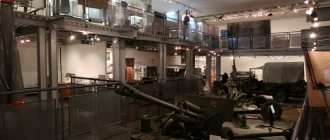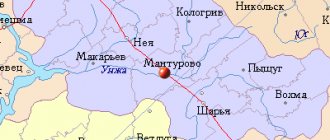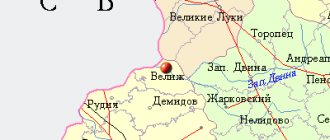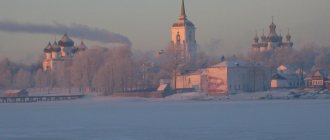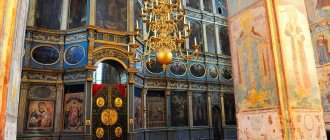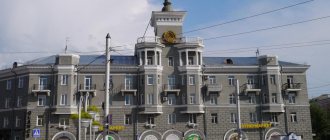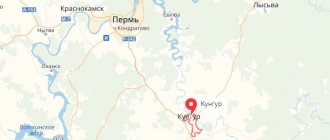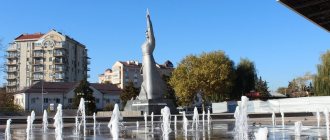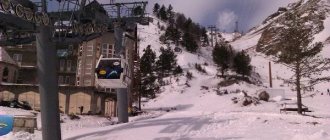Korolev
(founded on December 26, 1938; until July 8, 1996 -
Kaliningrad
) - a city in the Moscow region of Russia, a science city (since April 12, 2001). Forms a city district of the same name. Population - 221,129 people. (2016). Korolyov is often unofficially called the space capital of Russia.
By Law of the Moscow Region No. 53/2014-OZ of May 21, 2014, the Yubileiny urban district became part of the Korolev urban district, and the abolished Yubileiny city became part of the city of Korolev (the reason for the merger was the lack of space for the development of the city of Korolev). The governor of the Moscow region previously did not rule out the possibility that the territories of adjacent municipalities would be annexed to the united district.
until 1938 -
Kalininsky
until 1996 -
Kaliningrad
Geography
The city is located northeast of Moscow, 23 km from the center and 6-7 km from the Moscow Ring Road along the Yaroslavskoye Highway.
Yaroslavskoe Highway is the western border of Korolev (excluding the Zalineiny District). The Losiny Ostrov National Park adjoins the city to the south, and holiday villages to the north and east. The Klyazma River flows through the city, as well as many small rivers (in the part of Losiny Ostrov). Forests within the city cover an area of 3,800 hectares. Also within the city limits there is part of the Yauzsky Wetland Complex tract. The area occupied by the city is 55.44 km². The area of the urban district is 55.47 km².
| Distance from Korolev to major cities (in a straight line)/(by road) | |||||||||
| Dmitrov ~51 km / 68 km. Dubna ~122 km / 125 km. Konakovo ~138 km / 150 km. Tver ~160 km / 165 km. St. Petersburg ~691 km / 700 km. | Pushkino ~3 km / 4 km. Sergiev Posad ~42 km / 47 km. Yaroslavl ~205 km / 221 km. Vologda ~378 km / 427. Arkhangelsk ~970 km / 1200 km. | Ivanteevka ~2 km / 3 km. Fryazino ~7 km / 15 km. Alexandrov ~86 km / 100 km. Kostroma ~272 km / 310 km. Sharya ~532 km / 630 km. Kirov ~761 km / 936 km. Perm ~1139 km / 1500 km. Ekaterinburg ~1010 km / 1430 km. Urai ~1651 km / 2300 km. | |||||||
| Lobnya ~22 km / 35 km. Khimki ~24 km / 29 km. Volokolamsk ~122 km / 140 km. Rzhev ~224 km / 250 km. Pskov ~618 km / 750 km. Riga ~850 km / 970 km. | Shchelkovo ~4 km / 6 km. Noginsk ~37 km / 42 km. Vladimir ~157 km / 167 km. Nizhny Novgorod ~ 388 km / 410 km. Cheboksary ~575 km / 640 km. Kazan ~700 km / 790 km. Naberezhnye Chelny ~900 km / 1100 km. Ufa ~1147 km / 1300 km. Chelyabinsk ~1480 km / 1700 km. | ||||||||
| Mytishchi ~2 km / 3 km. Moscow ~3 km / 5 km. Obninsk ~140 km / 150 km. Kaluga ~182 km / 215 km. Bryansk ~367 km / 420 km. Kyiv ~770 km / 880 km. Bucharest ~1522 km / 1900 km. | Lyubertsy ~23 km / 36 km. Podolsk ~51 km / 66 km. Serpukhov ~124 km / 132 km. Tula ~191 km / 210 km. Voronezh ~470 km / 530 km. Volgograd ~910 km / 990 km. Krasnodar ~1211 km / 1400 km. | Balashikha ~7 km / 18 km. . Zhukovsky ~36 km / 52 km. Yegoryevsk ~90 km / 120 km. Kolomna ~110 km / 135 km. Ryazan ~175 km / 210 km. Boot ~285 km / 345 km. Tambov ~395 km / 495 km. Astrakhan ~1270 km / 1400 km. Baku ~1942 km / 2400 km. | |||||||
The forest is nearby
| Korolev is considered a very environmentally friendly city - mainly due to the “Losiny Island” adjacent to the south (of the 5.5 thousand hectares that the city occupies, 3.8 thousand hectares are forested) If on average in the Moscow region there are 10 ,37 sq. m of green area, then in Korolev this figure is 79 sq.m, i.e. 7.6 times more! Moreover, 27% of Korolev’s territory is occupied by parks and squares; There are 10 open reservoirs within the city. |
Each microdistrict has its own parks - for example, near the Kostino Palace of Culture there is a small old park with children's attractions, near a former estate, in Podlipki near the Palace of Culture, etc. A green area stretches along the water canal, not very landscaped, but you can walk and ride there on bicycles.
Park near the Kostino Palace of Culture
Residential areas are located quite compactly in the city center, and industrial areas and factories are located on the outskirts. In addition to enterprises, heavy congestion on the streets and active construction within the city have a negative impact on the environment. The queens also don’t like the state of the streets in the off-season. In spring, huge puddles form and the roads are dirty. This makes the city noticeably different from Moscow districts, even the most remote ones. The streets are cleaned worse in Korolev than in the capital, residents note. It’s relatively clean in old Podlipki, on Korolev Avenue, but already on Kosmonavtov Avenue, closer to the railway line, it’s a disaster.
Climate
The climate of the city of Korolev, as well as the entire Moscow region, is temperate continental, slightly different from the climate of Moscow. In winter it is somewhat colder here, and in summer (June is warmer here than August) it is not as hot and stuffy as in the Russian capital, and there is slightly less precipitation. The coldest month, unlike the regional center, is January, and March here is colder than November. Thaws are also common in December. .
| Climate of Korolev (norm 1836—2016) | |||||||||||||
| Index | Jan. | Feb. | March | Apr. | May | June | July | Aug. | Sep. | Oct. | Nov. | Dec. | Year |
| Average maximum, °C | −6,4 | −4,8 | 0,8 | 10,3 | 17,9 | 21,9 | 23,4 | 21,4 | 15,2 | 7,8 | 0,4 | −3,7 | 9,1 |
| Average temperature, °C | −9,4 | −8,3 | −2,9 | 5,9 | 12,6 | 16,7 | 18,5 | 16,6 | 11,1 | 4,9 | −1,8 | −6,3 | 5,4 |
| Average minimum, °C | −12,4 | −11,7 | −6,3 | 1,5 | 7,3 | 11,6 | 13,6 | 11,9 | 7 | 2 | −4 | −8,9 | 1,8 |
| Precipitation rate, mm | 41 | 34 | 32 | 42 | 50 | 75 | 90 | 74 | 62 | 60 | 56 | 52 | 668 |
| Source: | |||||||||||||
A little about prices
On the secondary market in Korolev, prices, on average, according to the federal portal “World of Apartments,” are about 97 thousand rubles per sq. m. m. One-room apartments cost 4.09 million rubles, two-room apartments - 5.54 million, three-room apartments - 7.18 million. In new buildings (without ownership documents) they are slightly cheaper: 82 thousand rubles per sq. m. m. “Odnushka” in a new house will cost an average of 3.97 million rubles, “kopeck piece” - 5.53 million, “treshka” - 6.97 million.
“On the outskirts, prices start from 60 thousand rubles, in the central region - from 95 thousand rubles per sq. m. m. On Korolev Avenue - already from 110 thousand rubles per sq. m. m,” says Elena Shchepkina.
And here is data on the primary market from Vladimir Bogdanyuk, head of analytical and consulting.
The cadastral value of real estate in Korolev is mainly in the range of 73–85 thousand rubles/sq.m. Renting royal apartments is a little lower in price than Moscow, but you can’t call it cheap. A one-room apartment is rented for an average of 23 thousand rubles, a two-room apartment for 27 thousand, a three-room apartment for 36 thousand.
Toponymy
The village of Podlipki arose as a dacha village at the end of the 19th century, since then its name has changed three times: the village of Kalininsky (after 1928), the city of Kaliningrad (after 1938), Korolev (after 1996). The name “Korolev” was given in honor of the designer of rocket and space systems S.P. Korolev, who headed Department 3 of the Special Design Bureau NII-88 (then OKB-1), located in this city, and Kalininsky and Kaliningrad - after the name of the state and party figure M.I. Kalinin, who took an active part in the activities of artillery plant No. 8 in the 1920s - 1930s. The name Kalinin was given to the plant in 1922.
Space Technology Museum
The name of this attraction, Queen of the Moscow Region, speaks for itself. Here are exhibits that characterize the history of the creation of our rocket and space technology: from the original Soviet long-range ballistic missiles to the Energia launch vehicle and the Sea Launch strategic rocket and space complex, from early artificially created Earth satellites to pilot-controlled space transport ships of various modifications.
The museum is represented by a showroom, the Labor Glory Hall and the S.P. Korolev Memorial Room.
Story
Main article: History of the city of Korolev
Coat of Arms (1988)
In the 12th century, settlements of Slavic tribes existed on the territory of the city, along the banks of the Klyazma River. An ancient water trade route from Moscow to the Vladimir-Suzdal principality passed through this area, and further - with access to the huge water artery of the continent - the river. Volga (Itil). The route passed along the rivers: Moscow-Yauza-Klyazma-Oka-Volga (with a portage from the Yauza (Mytishchi, MMZ plant) to Klyazma (Bolshevo, Shapkin Bridge)). At the beginning of the 18th century, one of the first industrial enterprises in Russia was organized here - a linen and cloth manufactory.
On the territory of modern Korolev, by the end of the 19th century, there were 14 large and small villages and hamlets: Bogorodskoye (Kostino), Bolshevo, Burkovo, Vlasovo, Gorodishche, Kurakino, Maksimkovo, Komarovka, Lapino, Baskaki (Baski), Ovrazhye (Zaovrazhye), Kakhovka ( Georgievskoe), Samarovka, Staraya Tarasovka.
In 1895, the Mytishchi-Shchelkovo railway line was put into operation and a railway station was built. Podlipki (later - Podlipki-Dachnye).
In 1918, the Ordnance Plant was transferred to the territory of the Podlipki holiday village from Petrograd. In 1928, the village of Podlipki was classified as a working settlement and received a new name - Kalininsky. By Decree of the Presidium of the Supreme Soviet of the RSFSR No. 1458/7 on December 26, 1938, the urban-type settlement of Kalininsky was transformed into the city of Kaliningrad.
In 1960, the city of Kostino was included in Kaliningrad; since 1963, the villages of Bolshevo, Pervomaisky and Tekstilshchik are administratively subordinate to the city.
In 1992, the city of Yubileiny was separated from Kaliningrad.
On July 8, 1996, the city was renamed from Kaliningrad to Korolev in honor of Sergei Pavlovich Korolev.
In 2003, the city included the urban-type settlements of Bolshevo, Pervomaisky and Tekstilshchik, previously administratively subordinate to it, in 2004 - the settlements of Torfopredpriyatie, Vodoprovodchik-5 and Pogonny [ source not specified 1858 days
], previously part of the Pushkinsky district.
In 2005, the Korolev urban district was formed - a municipal entity that includes the city of Korolev and surrounding areas.
In 2014, the city of Yubileiny was again included in the city of Korolev.
Mission Control Center
The Mission Control Center was established in October 1960 in this town as a computer center that allows processing and analyzing information received from the first space devices.
At the present time, the Center is still functioning and carries out flight control of the department of the Russian part of the International Space Station, both manned vehicles and those operating in automatic mode.
MCC employees will help organize visits to the center for both Russian and foreign citizens. As you tour this Korolev landmark, you will visit the hall from which the laurel-crowned Mir orbital station has been operated for the past fifteen years. You will also be able to see the Main Mission Control Hall of the International Space Station, and most importantly, it is rare for anyone to be able to observe the work of managing the orbital complex in real time.
You will hear many different stories about the arrangement and activities of the Center, you will be able to watch fascinating videos about the life of astronauts in orbit, but nothing compares to the opportunity to observe in real time the control of the orbital station.
Population
| Population | ||||||||||
| 1931 | 1939 | 1959 | 1962 | 1967 | 1970 | 1975 | 1976 | 1979 | 1982 | 1985 |
| 2800 | ↗44 000 | ↘41 427 | ↗76 000 | ↗96 000 | ↗105 945 | ↗107 000 | →107 000 | ↗133 470 | ↗138 000 | ↘125 000 |
| 1986 | 1987 | 1989 | 1990 | 1991 | 1992 | 1993 | 1994 | 1995 | 1996 | 1997 |
| ↘124 000 | ↗146 000 | ↗159 363 | ↘137 000 | ↘136 000 | →136 000 | →136 000 | ↘135 000 | →135 000 | ↘134 000 | →134 000 |
| 1998 | 1999 | 2000 | 2001 | 2002 | 2003 | 2004 | 2005 | 2006 | 2007 | 2008 |
| →134 000 | ↘133 200 | ↘132 400 | ↗132 900 | ↗143 000 | ↘142 600 | ↗170 700 | ↗171 600 | ↗172 800 | ↗173 600 | ↗174 600 |
| 2009 | 2010 | 2011 | 2012 | 2013 | 2014 | 2015 | 2016 | 2017 | ||
| ↗175 360 | ↗183 402 | ↘183 398 | ↗185 643 | ↗187 284 | ↗187 811 | ↗220 947 | ↗221 129 | ↗221 797 | ||
As of January 1, 2016, the city ranked 93rd out of 1,112 cities in the Russian Federation in terms of population
The city of Yubileiny was “interspersed” within the territory of the city of Korolev (it was previously under its administrative subordination); the total population of both cities, according to the 2010 census, exceeded 220 thousand people. On June 2, 2014, the former city of Yubileiny officially became part of the city of Korolev.
After the absorption of Yubileiny, Korolev became the third city in the Moscow region in terms of population after Balashikha (450,771) and Khimki (244,668).
Korolev urban district
During the implementation of the Federal Law “On the general principles of organizing local self-government in the Russian Federation” (No. 131-FZ of October 6, 2003, entered into force on January 1, 2006), municipalities were created in the Moscow region. In 2005, the municipal formation “city of Korolev, Moscow region” was transformed into the urban district of Korolev, which included 1 settlement - the city of Korolev.
Geographical data
The area of the urban district is 5,547 hectares. Initially, in 2005, the area was set at 5,195 hectares, which was subsequently clarified. At the same time, the area of the city proper within its traditional boundaries was 3,882 hectares. The boundaries of the city and urban district coincide.
The municipality borders:
- with the urban district of Ivanteevka (in the northeast),
- with the urban settlement of Shchelkovo, Shchelkovo municipal district (in the east),
- with the urban settlement of Zagoryansky, Shchelkovsky municipal district (in the east),
- with the urban district of Balashikha (in the south),
- with the urban settlement of Mytishchi, Mytishchi municipal district (in the west),
- with the rural settlement of Tarasovskoye, Pushkin municipal district (in the north),
Authorities
The local government authorities of the Korolev urban district are:
- The Council of Deputies of the city of Korolev, Moscow Region
is an elected representative body of local government. It consists of 25 deputies elected for a period of 5 years - The head of the city of Korolev, Moscow Region,
is a person who is elected by deputies of the Council of Deputies from among its members for the term of office of the Council of Deputies. He also exercises the powers of the Chairman of the Council of Deputies. - The administration of the city of Korolev, Moscow region
, is the executive and administrative body of local government. The head of the administration is appointed by contract.
From March 1996 to August 2009, the head of the city was Alexander Morozenko, who was temporarily removed from office by decision of the Korolyovsky City Court. Since 2009, Andrei Borisovich Kapustyan has acted as the mayor of the city.
By the decision of the Council of Deputies of the city of Korolev dated July 27, 2011, the powers of A. F. Morozenko were terminated early. V. A. Minakov was elected head of the city. On April 4, 2014, Valery Minakov resigned. Valery Myasoedov was appointed acting head of the city.
On September 14, 2014, the candidate from the United Russia party, Alexander Khodyrev, was elected head of Korolev.
Briefly about new buildings
The new residential complexes of Korolev are mainly monolithic brick multi-storey comfort-class buildings. In the Est-a-Tet company, as of October 2014, the supply volume was about 500 apartments, “which is almost 2 times less compared to the same period last year,” notes Vladimir Bogdanyuk. “The market for new buildings in the city has not been replenished with new projects for a long time, and the current ones are mostly in the final stages of construction.”
“The majority of residential buildings are being built in the south of the city - in the area of Gorky Street, Kosmonavtov Avenue, Uritsky and Proletarskaya streets. The average cost of a meter varies from 70 to 100 thousand rubles,” says Ekaterina Kurgina.
Seven monolithic buildings of the Golden Gate microdistrict have already been commissioned (developed by Rusinvest) on the street. Pionerskaya, apartments are being sold. New buildings are also being built. However, this area is not very favorable, the street is always busy, the noisy and polluted Yaroslavka passes nearby, and the TsNIIMASH industrial zone is located. This disadvantage is balanced by the proximity of the Podlipki-Dachnye station. Two-room apartment 57 sq. m costs 5.07 million rubles.
Three houses on Tarasovskaya Street should be commissioned by the end of the year. This is in the north-west of the city, also not far from the Yaroslavl highway. The area is located “on the outskirts”, far from city infrastructure. In the Tarasovskaya 2 residential complex, the cost per square meter is from 67,000 rubles, the area of apartments is from 26.5 sq. m. m. At “Tarasovskaya, 14” a meter already costs 72,000 rubles, the size of apartments starts from 27.3 sq. m. m. “Tarasovskaya, 25” costs 69,000 rubles/sq.m. m, apartment area - from 30.5 sq. m. In all these three buildings, studio apartments, one-room, two- and three-room apartments are sold.
The Sputnik residential complex, the developer of which was the Skygrad Group of Companies, is a 16-storey building with underground parking, located on the street. Marina Tsvetaeva, not far from the poet’s house-museum. Its location is convenient and, perhaps, the best of all royal new buildings: near a park and Bolshevo station. The only thing that can disturb you is the noise from passing trains, since the railway line is very close.
Low-rise residential complex "Valentinovka Park"
Low-rise construction in the city is represented by the Valentinovka Park residential complex (built by Granelle Development Group), between the street. Gorky and Valentinovka station. “Valentinovka Park” is 23 buildings of 3-story houses with all the infrastructure and amenities. Small apartments for sale here, from 31 sq. m - from at prices from 2.6 million rubles.
Elizaveta Gudz claims that another low-rise project will soon be launched in Korolev.
One of the attractive projects is the Druzhba microdistrict, which is being built nearby, on the street. Silikatnaya, 4. This is the Strela residential complex. There are four 17-story panel-brick buildings here. Nearby there is a bus station, the Zvezdny shopping center, a forest, and a lake. Construction is being carried out by Okhra LLC, delivery is scheduled for the end of this year. One-room apartments 47 sq. m there you can buy from 3.75 million rubles.
Residential complex "Strela" is being built in the Druzhba microdistrict
In 2012, about 70 thousand square meters were commissioned in Korolev. m of housing, in 2013 - 142 thousand sq. m. m. In 2014, 283 thousand sq. m. will be built. m. Plans for the future are completely Napoleonic: by 2022 it is planned to build about 1.7 million square meters. m. By that time, the city's population is expected to increase by another 10 thousand people.
Internal division
Central part of the city
Korolev is divided into several historical districts and parts, often named after former settlements absorbed by the city during its development:
- Central part - Podlipki, New Podlipki, Zavokzalny, Zalineiny, 45th quarter, Kostino, Samarovka.
- Bolshevo microdistrict - Bolshevo, Burkovo, Committee Forest, Valentinovka.
- Microdistrict Oboldino
- Microdistrict Pervomaisky - Factory 1 May, New Gorki, Lesnye Gorki, Starye Gorki, Goznak, Komarovka, Maksimkovo.
- Tekstilshchik microdistrict - Advanced textile worker, Kalinina village, 43rd quarter.
- Microdistrict Torfopredpriyatie - Torfopredpriyatiye, 12th switch, Pogonny.
- Microdistrict Yubileiny - 1st town, 2nd town, 3rd town, 4th town.
Education
There are 42 municipal kindergartens in the city. Additional education is provided by language centers, sports schools, and art schools. The city's enterprises employ a large number of famous scientists and inventors, including academicians, about a hundred doctors and more than a thousand candidates of science. Approximately 67% of residents have higher or secondary technical education; according to this indicator, the city ranks one of the first places in Russia.
There are 85 educational institutions in the city:
- 25 municipal educational institutions,
- 38 municipal preschool institutions,
- municipal health and educational institution "Rodnik" (located on the territory of the Pushkinsky district, village of Zverosovkhoz),
- MOU DO "Training and Methodological Educational Center",
- Municipal educational institution for children in need of psychological, pedagogical and medical and social assistance “Center for Psychological and Pedagogical Rehabilitation and Correction”,
- 13 institutions of further education,
- 3 institutions of primary vocational education,
- 3 institutions of secondary vocational education.
The city operates a non-state educational institution of additional education, the Children's Art School of Folk Crafts "Renaissance".
Preschool education
There are 36 kindergartens in Korolev, one of which is departmental (No. 2 “Lesovichok” at RSC Energia). About 5,000 children are raised there.
In Korolev there are institutions of musical, aesthetic, artistic, environmental and folk arts.
For children in need of treatment or rehabilitation, there are special kindergartens.
Schools
School No. 18
There are 29 schools in the city, of which: 17 general education, 5 gymnasiums, 1 Lyceum of scientific and engineering profile, Lyceum No. 19 with a physics and mathematics focus, 1 pro-gymnasium, 1 special boarding school for blind and visually impaired children, 1 correctional school, 1 school -boarding school, 1 evening school (closed in 2012 by decision of the administration of the city of Korolev). Students from city schools regularly become prize-winners and winners of regional, all-Russian and international subject Olympiads; 94% of city school graduates enter universities, including the best universities in Moscow and the Moscow region. The International Space Olympiad is held annually - a scientific competition in which Moscow region and Russian schoolchildren can compete with their peers from the USA, France, Germany, Great Britain, Greece, Kazakhstan, Australia and other countries. There is also an international educational program “Space and Children”. As part of the “Gifted Children” program, an international space camp for schoolchildren, city subject Olympiads, honoring the winners of subject Olympiads on the eve of Cosmonautics Day, awarding scholarships from the Head of the City to students who have shown high results in Olympiads, and a city school graduation ball are held. In Korolev there is also a Children's Ecological Center of the Losiny Ostrov National Park.
Children who need special educational programs study at correctional school No. 21, a boarding school for the blind and visually impaired, and a sanatorium-forest school.
Since 1990, the city competition “Teacher of the Year” has been held as part of the annual regional competition “Teacher of the Year in the Moscow Region”.
Professional education
Institutions of secondary vocational education
train specialists for aerospace industry enterprises and for the needs of the city as a whole.
- Professional College named after S.P. Korolev,
- Korolev College of Space Engineering and Technology (KKKMT) is a branch of the Financial and Technological Academy of the Moscow Region,
- Korolyovsky State College of Technology and Fashion Design (KGTTDO) is a branch of the Technological University of the Moscow Region.
In total, training is provided in more than 40 specialties; a professional skills competition is held annually among young workers and students of educational institutions. In order to improve methodological work, organize internships and improve the qualifications of workers in the primary education system, the Regional Resource Center operates on the basis of vocational lyceum No. 26. [ source not specified 198 days
]
Higher education
Higher education in the city is represented by branches of the country's leading universities, public and private institutions:
- Faculty of Rocket and Space Technology MSTU. N. E. Bauman, faculties and departments of the Moscow Aviation Institute (Technical University). [ source not specified 626 days
] - Royal Branch of the International Law Institute
- Branch of NOCHU VPO "Moscow New Law Institute" (in Yubileiny)
- Financial and Technological Academy of the Moscow Region (FTA) (formerly the Royal Institute of Management, Economics and Sociology (KIUES))
- Institute of International Business "Classical Business School"
- Representative office of the IFPA in Korolev.
- JSC "Institute for training personnel in mechanical engineering and instrument making "Mashpribor""
Royal museums and theaters
Korolev is not only a citadel of science, but also a cultural center. The city has museums and theaters for people of all ages.
Royal History Museum
- Address: st. Tereshkova, 1.
The main Korolev Museum was formed in 2005 and united several old museums: space, history and local history. The opening was timed to coincide with the 60th anniversary of the Great Victory. The exhibitions cover the history of the space and defense industry in Korolev, and also demonstrate the life of the inhabitants of the Russian Empire and the Soviet Union. The museum features the largest collection of military and civilian vehicles.
Kostino Estate Museum
- Address: st. Ilyich, 1A.
At different times, interesting historical figures lived in the estate in the village of Kostino: the Dolgoruky princes and the revolutionary Vladimir Lenin. The modern building was built at the beginning of the 20th century; in 1922, the “Father of the Revolution” lived in it. At that time, Vladimir Ilyich was already seriously ill and soon moved to Moscow, where he died two years later.
In 1924, troubled teenagers, orphans and street children began to be brought to Kostino. The estate became a kind of labor correctional colony for juvenile delinquents. In 1939, the estate was transformed into a museum in memory of Lenin. Over time, the profile of the museum expanded to include local history and art exhibitions.
House-Museum of S.N. Durylina
- Address: Svobodnaya st., 12, Bolshevo microdistrict.
Sergei Nikolaevich Durylin is one of the most famous residents of Korolev, a writer and scientist who studied issues of philosophy and theology. In 1936, the writer settled with his wife in a small log house with an unusual semicircular projection.
Famous artists and writers often came to see the theologian, including the famous painter M. Nesterov. Here Sergei Nikolaevich ended his earthly journey.
In 1993, the house was transformed into a museum in memory of the poet; many personal belongings of the writer were preserved inside, such as furniture, books, photographs, as well as a rich collection of paintings by Soviet and Russian artists and ancient icons.
House-Museum of O.M. Kuvaeva
- Address: Bolshevskoye sh., 31.
Oleg Mikhailovich Kuvaev is an outstanding Soviet geologist, writer, screenwriter, who became famous thanks to his stories and essays about geological expeditions. The author’s most important work is the novel “Territory,” which has been reprinted dozens of times, translated into many languages and filmed twice in 1978 and 2014.
In the 60s, Kuvaev decided to leave geology and devote himself entirely to writing prose. In 1966, Oleg Mikhailovich settled in Kaliningrad near Moscow and lived there until his death in 1975. The writer’s sister and nephew founded a museum in the house in memory of the famous relative. The house contains the geologist’s personal belongings and various editions of his works.
Drama Theater
- Address: st. Tereshkova, 1.
Many residents of Korolev are not only intellectually, but also creatively gifted people who value theatrical art. The first performances in Podlipki began to take place back in 1924. Despite repeated changes in the names of the village and city, the theater remained the “Comedy and Drama Theater in Podlipki” until 2005.
For many years the repertoire consisted mainly of folk works. In 2005, the post of artistic director was taken by Andrei Kryuchkov, who radically changed both the direction of the theater and its cast.
Theater for Young Spectators
- Address: Kaliningradskaya st., 12.
Residents of Korolev care about cultural leisure not only for adults, but also for children. In 1994, the Theater for Young Spectators opened in the city. The first amateur performances took place back in 1976 at the children's club of the local House of Culture.
In 1983, the amateur theater received the status of “folk”, and 11 years later it became professional. In 2002, the Youth Theater moved to a separate building. Little queens not only watch fairy-tale performances, but also learn acting skills and participate in productions.
Read in the topic: The best attractions of the Moscow region
Economy
On Cosmonauts Avenue, Forest Hotel
The basis for the socio-economic development of the city of Korolev is the city-forming scientific and production complex.
Korolev is one of the largest research and production centers in the Moscow region, in the pre-war years it was a center for the development of artillery; since the 1950s, the creation of a number of research institutes, design bureaus, factories began, which became the basis of the country’s rocket and space industry, and also, to one degree or another , city-forming:
- RSC Energia named after. S.P. Koroleva is a leading enterprise in the Russian space industry.
- TsNIIMASH (including the Flight Control Center).
- JSC Tactical Missile Weapons Corporation (KTRV) develops and produces a wide range of combat missile systems and aviation systems.
- NPO Measuring Technology - carries out the development and research of information-measuring complexes and systems, information and telemetry support, diagnostic, monitoring and control tools, sensors, and converting equipment.
- Chemical Engineering Design Bureau named after. A. M. Isaeva (branch of the Khrunichev State Research and Production Space Center) is one of the leading design bureaus in the field of development and testing of liquid rocket engines, propulsion systems and their components.
- JSC "Composite" is the most important organization in the field of materials science of rocket and space technology, carrying out R&D on the creation and comprehensive study of the properties of materials.
- Research Institute of Space Systems named after. A. A. Maksimova (branch of the Khrunichev State Research and Production Space Center) - is engaged in research and experimental work on the creation of new equipment and advanced technologies: space, energy-saving (including alternative energy sources), monitoring systems for objects and natural resources.
- 160th House-Building Plant "Moscow Region" - production of house-building products for city construction projects, cottages, baths.
- NVP "Bolid" - technical means of security, access control, video surveillance, automation and dispatch systems.
- KorolevPharm LLC is engaged in the contract production of cosmetics and biologically active food additives under the customer’s trademark. Produces extracts using an electrodynamic method from plant materials, as well as animal and mineral origin.
The city is home to woodworking, instrument-making and textile enterprises. A division of the Alfa Laval concern is OJSC Alfa Laval Potok.
Exhibits
In the showroom of this Korolev landmark there is everything: rockets, satellites, and the whole history of domestic and Soviet rocket and space technology unfolds before your eyes.
The Hall of Labor Glory is history in the faces of those people who made it happen, but remained behind the scenes, the history of ordinary hard workers, without whom the plans of great scientists and designers would be very problematic to bring to life. Everything is present here: photographs, documentary sources, awards, souvenirs, etc.
The Memorial Room of S.P. Korolev depicts the life of a common man, everything that a common man needed in modern conditions to create.
In addition, visiting any Korolev attraction is not just an opportunity to touch history, it is a chance to observe it. Seeing and touching the device on which Yuri Gagarin returned home is something beyond words. And full-scale models of the original international orbital complex "Soyuz-Apollo" and the station located in orbit, "Salyut", with their similarity, provide an opportunity to touch the history of mankind.
Connection
There are 20 post offices. Post offices in the central part
| Name | Index | Address |
| Korolev | 141070 | st. Kalinina, 15 |
| Korolev-1 | 141071 | st. Pavlova, 2 |
| Korolev-2 | 141072 | st. 50th anniversary of the Komsomol, 13a |
| Korolev-3 | 141073 | st. Nakhimova, 39/36 |
| Korolev-4 | 141074 | st. Pionerskaya, 16 |
| Korolev-5 | 141075 | Kooperativnaya st., 8a |
| Korolev-6 | 141076 | st. Michurina, 7 |
| Korolev-7 | 141077 | Koroleva Avenue, 11 |
| Korolev-8 | 141078 | Koroleva Avenue, 1/6 |
| Korolev-9 | 141079 | st. Gagarina, 11 |
| Korolev-10 | 141080 | st. Gagarina, 2a |
Post offices in neighborhoods
| Name | Index | Address |
| Bolshevo | 141060 | st. Prudnaya, 7 |
| Bolshevo-5 | 141065 | st. Gaidara, 5/1 |
| Bolshevo-7 | 141067 | st. Committee Forest, 2a |
| Pervomaisky | 141069 | st. Sovetskaya, 36 |
| textile worker | 141068 | st. Tarasovskaya, 1 |
| Anniversary | 141090 | st. I. D. Papanina, no. 8 |
| Yubileiny-1 | 141091 | st. Heroev Kursantov, 11 |
| Anniversary | 141092 | st. Tikhonravova, 32a |
Transport
Main article: Korolev Transport
Electric train ED4M-0226 on the square. Bolshevo (Fryazino direction), 2008
The railway connects Korolev with Moscow (Yaroslavsky station), cities and towns of Shchelkovsky and Noginsky districts, Mytishchi, Ivanteevka, Fryazino. The following stations and platforms are located within the city:
- Podlipki-Dachnye station
- Bolshevo station, consisting of two platforms: Moninsky direction and Fryazinsky direction.
- platform Valentinovka (on the Moninsky direction)
- platform Fabrika 1 May (in the Fryazino direction)
The interval of electric trains during rush hour at the station. Podlipki-Dachnye, Bolshevo - 7-10 minutes, outside rush hour - up to 30 minutes. The interval on the platforms in the Fryazino direction is 20-40 minutes. On weekdays there is the so-called. “technological window” (from approximately 11 a.m. to 1 p.m.), during which electric trains do not operate.
On September 5, 2008, the Sputnik high-speed electric train was launched at intervals of 30 minutes during peak hours.
Bus service
Bus service to the population is provided by two carriers - State Unitary Enterprise MO "Mostransavto" (Korolevskoe PATP) and LLC "Avtotravel". The following routes operate in the city:
Higer bus route 392 near VDNH metro station
- 1 (Silikatnaya St. - Bolshevo Station - Podlipki Station - Silikatnaya St.)
- 2 (Silikatnaya St. - Podlipki Station - Bolshevo Station - Silikatnaya St.)
- 3 (Silikatnaya St. - Podlipki Station
- 4 (Silikatnaya street - Bolshevo station - Podlipki station - Market on Yauza)
- 5 (Michurina St. - Podlipki Station)
- 6 (st. Bolshevo - Michurina st. - Oboldino)
- 7 (Bolshevo station - Michurina street - Peat enterprise)
- 7 (Bolshevo station - Michurina street)
- 8 ((Valentinovka square) - Grazhdanskaya street - Bolshevo station - Podlipki station)
- 9 (Gastronomy - Bolshevo station - TsNIIMASH)
- 10 (station Podlipki - Committee Forest)
- 11 (Bolshevo station - Bolshevo holiday home)
- 12 (st. Podlipki - Forest School - st. Bolshevo)
- 13 (st. Podlipki - Forest School - st. Bolshevo - st. Podlipki)
- 14 (st. Bolshevo - Krasnaya Nov)
- 15 (Podlipki station - Gorodok 3 - Bolshevo station)
- 15 (station Podlipki - Gorodok 3)
- 16 (station Podlipki – Forest School)
- 17 (Lermontov St. - Podlipki Station)
- 19 (Town 1 - Town 2)
- 26 (st. Bolshevo - Nevzorovo)
- 28 (Silikatnaya street - Bolshevo station - Podlipki station - Mytishchi station)
- 31 (Lesnye Polyany - Bolshevo station - Podlipki station)
- 31 (st. Bolshevo - Lesnye Polyany)
- 32 (st. Podlipki - Mytishchi (MGUL))
- 44 (Silikatnaya St. - Bolshevo station - Lesnye Polyany - Pushkino station)
- 45 (Podlipki station - Pushkino station)
- 48 (Bolshevo station - Gorky street - Zagoryanskaya square)
- 58 (Podlipki station - Bolshevo station - Zagoryanskaya square - Shchelkovo station)
- 392 (Silikatnaya street - Bolshevo station - Podlipki station - Moscow (metro station VDNKh))
- 499 (st. Bolshevo - Gorodok 3 - Moscow (metro station VDNH))
- 551 (Lesnye Polyany (Polyanka microdistrict) - Forest School - Moscow (metro station VDNKh))
- 565 (Michurina St. - Moscow (metro station VDNKh))
- 576 (Silikatnaya St. - Moscow (metro station VDNKh))
Buses 6, 7, 9, 12, 14, 16, 26, 28, 48 routes follow the schedule, the interval of other buses and minibuses is from 2-3 to 15-20 minutes.
Old is new
The development of the old districts of Korolev is dominated by panel buildings of 9–16 storeys of the “Moscow” series, in Yubileiny there are 5–10-storey panels. Since 2000, monolithic brick houses and townhouses began to be built in Korolev. Thus, Korolev already has a significant stock of secondary real estate, built using modern technologies and standards. It is not surprising that prices for such “new resale” are somewhat higher. For example, on the street. Frunze, 1a (monolithic brick house built in 2006, price per sq. m. - above 115 thousand rubles), on the street. Kominterna, 12 (monolithic brick house built in 2006, price per sq. m - above 115 thousand rubles).
Another example is the houses on Mayakovskogo, 18, inhabited 17-story buildings built in 2005, 5 buildings with landscaped territory, a playground and a parking lot. Now apartments here are sold for approximately 105 thousand rubles/sq.m. In 2008, the “Three Bogatyrya” residential complex was commissioned at 18 Komitetsky Les. This is a monolithic brick 16-story building built in 2008. Located in the former city of Yubilein, which has now become the Korolev district. Apartments here are sold for approximately 95 thousand rubles/sq.m. m.
A year ago, the residential complex “Delta” was commissioned on the street. Field. The 4-section, 22-story house is located near the Klyazma River and a large pond. The cost per square meter is about 95 thousand rubles.
Residential complex "Cherry Orchard" on Chekhova, 13. This is a monolithic brick 16-storey building with a landscaped area and a children's playground.
Townhouses with plots of 2–4 acres can be found in the area of the street. Gorky, on both sides of Cosmonauts Avenue. In the same area you can find unfinished brick duplexes for 5–6 million rubles, with central communications and the possibility of registration.
There are also business class offers in Korolev. For example, located next to Losiny Ostrov, there is a low-rise residential complex “Premium” with a protected area and terraces (Podlesnaya St., 11). The cost of apartments here, according to Ekaterina Kurgina, consultant in the residential real estate valuation department of the Uphill consulting group, starts from 12 million rubles. A similar project is the Sosnovy Bor club house, essentially townhouses with an area of 240 square meters. m (developed by YIT-DOM) with prices starting from 11 million rubles.
Culture
View of Korolev Avenue and the first book house of the MZhK
6 large cultural centers, 2 concert halls, 4 museums, an art school, children's and technical creativity centers, theater groups, a "Musical Theater", a film and television school, children's theater schools. In the city there is a branch of the Moscow Regional State Scientific Library named after. N. K. Krupskaya (Moscow State Scientific Library named after N. K. Krupskaya). House-museums of Vladimir Lenin (museum of history and local lore), historical museum (in the building of the former Zvezda cinema, Marina Tsvetaeva, Sergei Durylin, house-museum [ source not specified 626 days
] writer Oleg Kuvaev.
DiKC (DC named after M.I. Kalinin) was awarded the distinction “For services to the Moscow region.”
A significant part of the cultural life of the city is the academic choir “Podlipki”, gold medalist of festivals in Bulgaria and Italy, participant and laureate of regional, regional and international competitions. For his contribution to the development of choral art, the director and conductor of the choir B. A. Tolochkov (1929-2001) was awarded the title “Honorary Citizen of the City of Korolev” in 1998.
During the Soviet period, a children's choir of the city of Kaliningrad was also created in the city under the direction of Anatoly Chmyrev.
Architectural monuments Queen
Korolev is a young city, but several architectural monuments of the 19th century have been preserved on its territory, as well as interesting examples of Soviet architectural thought.
Lapino-Spasskoye Estate
- Address: microdistrict Pervomaisky, st. Sovetskaya, 9.
The estate in the village of Lapino appeared in the 19th century thanks to the local manufacturer Panteleev. In subsequent years, the estate changed several owners, and the last owner of the mansion and adjacent buildings was entrepreneur A.N. Craft. After the change of government, the estate turned into socialist property and served the working people.
Several buildings have survived to this day, among which the three-story manor house and a small one-story outbuilding stand out. The main house housed a kindergarten; a music school still operates in the outbuilding. The mansion requires major renovations; the building is currently abandoned.
Culture and Leisure Center
- Address: Sovetskaya st., 71, Pervomaisky microdistrict.
The building of the cultural center in Bolshevo is an architectural monument of the 19th century. Initially, the simple brick building belonged to a dyeing factory and only in Soviet times became the main cultural attraction of the village.
For a long time, the youth club “Fakel” worked here; club members organized the first drama club in the settlement. Today the center accommodates more than a dozen creative groups, children's clubs and interest clubs.
First house of MZhK
- Address: ave. Koroleva, 18/6.
The youth residential complex is a unique example of Soviet architecture. From 1971 to 1991, massive construction projects took place throughout the Union, and houses were erected for young families. At the beginning of the all-Union experiment, young builders from all over the country came to Kaliningrad, the future Korolev.
It was here that the very first multi-storey building of the complex was built. The façade of the building, like a beehive, consists entirely of cell-balconies. Some of the apartments are still occupied by the families of the original residents.
Attractions
In the historical part of Korolev, Bolshevo, in the 1920-1930s there was the Bolshevo labor commune of the OGPU. Her first capital building of the commune was the Construction Bureau House in Bolshevo, a residential building in the constructivist style, built in 1928 according to the design of the architect Arkady Langman. In November 2013, wall paintings by Vasily Maslov were discovered here. Some of them were dismantled for restoration; the remaining volume of paintings, preserved on site, was lost during the illegal demolition of the building carried out on the night of March 7-8, 2015.
In Korolev there is the country's first Youth Residential Complex (YRC), the first house of which was built and occupied in 1976. For their characteristic shape, reminiscent of the CMEA building, and now the government of Moscow, when viewed from the front, these houses were nicknamed “books”
. The first of three such “books” is located at 18/6 Korolev Ave., the main street of Korolev.
The closed part of the Eastern Water Canal, designed to deliver water from the Uchinsky (Akulovsky) reservoir to Moscow, runs through the territory of Korolev. The area adjacent to the water utility is a sanitary protection zone.
Monuments
- Monument to Sergei Pavlovich Korolev on Korolev Avenue, sculptor S. A. Shcherbakov;
- Monument to S.P. Korolev on the territory of RSC Energia named after. S. P. Koroleva;
- Monuments to soldiers who died in the Great Patriotic War of 1941-1945, on Victory Square and st. Ilyich;
- Monument to V.I. Lenin on F.E. Dzerzhinsky Square, in front of the main building of RSC Energia;
- Monument to F. E. Dzerzhinsky on the street. A. Matrosova;
- Monument to Yu. A. Mozzhorin on Bogomolov Street;
- Monument in honor of the launch of the first artificial Earth satellite on Cosmonauts Avenue;
- Monument to V.I. Lenin on the territory of the Federal State Unitary Enterprise "TsNIIMASH";
- Monument to V.I. Lenin at the central entrance of JSC Tactical Missile Weapons Corporation;
- Memorial stone in honor of the 50th anniversary of the first human flight into space;
- Obelisk to fellow countrymen who died during the Second World War, on Central Street in the Torforazrabotki microdistrict;
- Monument to Major General Alexander Naumov in the park named after Naumov, sculptor Sergei Lopukhov;
- Monument with the R-2 missile at the entrance to the city from the Yaroslavl highway;
- Monument with the R-7 Vostok launch vehicle on the territory of RSC Energia named after. S. P. Koroleva;
- A monument with a reduced copy of the Energia-Buran system on the territory of RSC Energia named after. S. P. Koroleva.
- Monument to Yu.A. Gagarin and S.P. Korolev in the park of space explorers near the Central House of Culture named after. Kalinina.
What to see in the city of Korolev in 1 day
The vast majority of people associate Korolev with science and space. Tourists come to the science city to get acquainted with the achievements of Soviet and Russian scientists. The city is also visited by fans of Marina Tsvetaeva, because it is here that one of the main museums in memory of the great poetess is located.
Mission Control Center
- Address: Pionerskaya st., 4, bldg. 1.
Korolev is the citadel of the Russian space industry. The famous MCC has been monitoring the movements and actions of spacecraft since the 60s. These days, the center hosts excursions where visitors can see with their own eyes the work of specialists and watch a live video broadcast from space. When visiting the MCC, you must turn off your mobile phones.
RSC Energia Museum
- Address: st. Lenina, 4A.
The modern Rocket and Space Corporation (RSC) is a direct descendant of the famous design bureau founded by Sergei Korolev. The corporation operates a museum dedicated to the history of space exploration. It contains the very first samples of spacesuits, artificial satellites, ballistic missiles and the real Vostok-2 spacecraft. In a separate room, experts reproduced the furnishings of Korolev’s office.
House-Museum of M.I. Tsvetaeva
- Address: st. Marina Tsvetaeva, 15.
Modern Korolev consists of several settlements, one of the oldest and most significant among them is the village of Bolshevo. Here, under the tall pines, a green wooden house with large windows was lost. The small mansion is the place where the famous poetess Marina Tsvetaeva lived in 1939 after returning from France.
Marina Ivanovna spent less than six months in the village, but the events that occurred during this period of time had a terrible impact on the future life of the long-suffering woman. After 17 years of emigration and life in poverty, Tsvetaeva was forced to return to her homeland, which greeted the poetess harshly and only prepared new challenges for her. After the arrest of her husband and daughter, Marina Ivanovna was left alone with her youngest son and had difficulty surviving without the help of family and friends.
The Tsvetaeva Museum began operating in 1992. The house contains objects that are related to the life and work of the famous poetess. The rooms have preserved original furniture and dishes that belonged to Marina Ivanovna. Near the entrance to the house, guests are greeted by a stone sculpture of Tsvetaeva.
Sport
Youth team of the Metalist football club
In Korolev there are 3 stadiums, 3 swimming pools. There are six federations in the city for such sports as football, boxing, sambo and judo, basketball, sports tourism and aircraft modeling. The main sports represented in the city are: bandy, field hockey, football, wrestling, boxing, swimming, gymnastics, volleyball, handball. Major competitions are held in Korolev: International Space Marathon in memory of Sergei Pavlovich Korolev, “Wicked Ball”, Russian Marathon Cup, matches of Russian championships in field hockey, chess, indoor hockey, floorball, bandy (first league - “Vympel”) , football (third division of the Russian Championship, zone “Moscow Region”, group B - “Metalist”; Moscow Region Championship, highest group - “Vympel”, “Metalist-Korolev-2”, “Vesta”), as well as competitions on a regional scale : championship in swimming, artistic gymnastics, memorial in memory of USSR pilot-cosmonaut V.N. Volkov (football), cross-country skiing competition for the prizes of M.A. Pochatova, individual championship in chess, cycling competition in memory of V.K. Kurlov, volleyball cup among women's teams, sports competitions for students of orphanages and boarding schools and others. The city also hosts other Russian competitions: triathlon, car rally, sports bridge, as well as a number of races. In 1997, the city bandy team resumed its participation in the Russian championship. In 2006, the Metalist youth team took bronze in the Moscow Regional Football Championship.
On the territory of the city there are three stadiums, six football fields, ten gyms, two skating rinks, four swimming pools, five tennis courts, six volleyball courts, three children's and youth sports schools - "Metalist", "Vympel" and "Debut". The V. L. Bashkirov School of Mountaineering trains young climbers on an artificial simulator built at Gymnasium No. 18 named after I. Ya. Ilyushin. In winter, there is an ice climbing track at the Metalist stadium. On December 26, 1998, competitions for the Russian Cup were held here, in which over 30 climbers took part. [ source not specified 198 days
]
Religion
There are 4 active Orthodox churches in Korolev: Trinity, Nativity of the Blessed Virgin Mary, Cosmas and Damian (1786), Hieromartyr Vladimir Metropolitan of Kyiv; 1 inactive: Transfiguration of the Lord (1800) and 1 chapel in honor of the Holy Blg. Prince Alexander Nevsky. The Church of Evangelical Christians-Baptists “Unity” and the Church of Christians of the Evangelical Faith “Exodus” operate in Korolev. The main office of the Regional charitable public organization "Bible League" is located in Korolev.
Religious centers of the city
For believers, Korolev has a number of objects of interest. Let's look at some of them.
The Church of Cosmas and Damian is the oldest landmark in the city
The date of construction of the wooden temple is 1585. More than 200 years later (in 1786), with the participation of P.I. Odoevsky, construction of a new building began, which has survived to this day. Inside the church, on a memorial plaque, it is attested that the burial of his daughter Daria Petrovna is located near the temple.
The wave of persecution aimed at combating religion did not spare the church itself and its clergy. The temple was subjected to destruction and robbery. Local residents managed to get permission from M.I. Kalinin to leave him alone. Restoration work was carried out by believers. People worked for free, bringing the necessary materials and icons from home. Other temples also provided assistance.
A valuable relic of the sanctuary is the icon of Cosmas and Damian with partial of their holy relics.
You can find the church at the address: Bolshevo microdistrict, Stantsionnaya street, 43.
Over the long history of its existence (since 1689), the Church of the Nativity of the Blessed Virgin Mary has had to endure more than one misfortune. Its finishing and equipment continued for 2 years. It was not large in size. It was built of red brick with white stone decorations. With the change of owners, changes occurred:
- under Princess Dolgorukova, the church was repaired and a wooden bell tower was built;
- the princess's daughter replaced the bell tower with a stone one;
- Kraft, who served as an elder in the church, equipped it with central heating.
Church of the Nativity of the Blessed Virgin Mary
After the temple was closed during Soviet times, it was subjected to repeated looting. The main shrine was stolen from it - the miraculous icon of the Smolensk Mother of God, which had been kept there for more than 200 years. Then a labor commune was located in the temple, and reconstruction took place. In 1954, the building was completely destroyed and a residential building was erected in its place. In 1995, a decision was made to revive the temple near this place. Since 2006, worship services have been resumed there.
Location: Kostino microdistrict, st. Kaliningradskaya, 1.
Passing by the Alexander Nevsky Chapel in the morning or evening, you can hear the melodic bell ringing
You can visit it by coming to Tsiolkovsky Street, 26.
It is part of the Memorial complex to fallen soldiers. The idea of the townspeople was that residents and guests of the city would have the opportunity to remember these people who gave their lives for our better future. The chapel was built with funds raised by the townspeople. By the start of work in 1998, this amount reached 200 thousand rubles. Inside it is equipped modestly, the room itself is small. You can talk with the priest on duty, or visit the church shop.
